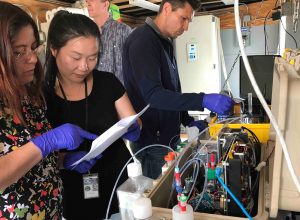Microbial contamination detection device to undergo more R&D after malfunction

A field-portable instrument prototype designed to improve the speed at which beach water can be analyzed for microbial contamination did not perform reliably during an initial field test and will undergo additional development.
SCCWRP and its member agencies completed testing on the device in May with the instrument’s co-developers. The testers determined that the component of the machine that uses a DNA-based approach to quantify microbial contamination appeared to be misaligned. Such issues are not unusual for a prototype instrument.
Meanwhile, the sample acquisition component, which prepares raw water samples for the DNA analysis, was able to produce comparable, high-quality results. It successfully filtered a variety of water sample types, including those with high turbidity and high algal bioamass, and produced DNA extracts of equal, and sometimes superior, quality to those obtained with standard laboratory equipment.
The Monterey Bay Aquarium Research Institute, which co-designed the instrument with a professor who is now at the University of Montana, is continuing to work to improve the instrument’s design.
Unlike traditional methods that require water samples to be brought to a lab for analysis – a process that can take up to 24 hours – the microbial contamination detection instrument is being designed as a field-deployable device, capable of producing results within two hours. The system is intended to be so simple to use that it could be operated by a lifeguard.
More news related to: Microbial Source Tracking, Microbial Water Quality